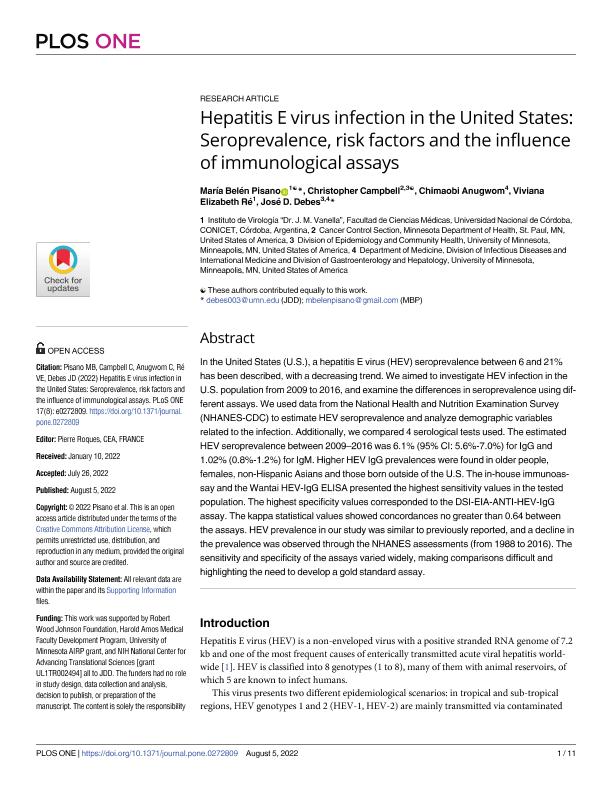Mostrar el registro sencillo del ítem
dc.contributor.author
Pisano, María Belén

dc.contributor.author
Campbell, Christopher
dc.contributor.author
Anugwom, Chimaobi
dc.contributor.author
Ré, Viviana Elizabeth

dc.contributor.author
Debes, José D.
dc.date.available
2024-01-04T14:01:39Z
dc.date.issued
2022-08
dc.identifier.citation
Pisano, María Belén; Campbell, Christopher; Anugwom, Chimaobi; Ré, Viviana Elizabeth; Debes, José D.; Hepatitis E virus infection in the United States: Seroprevalence, risk factors and the influence of immunological assays; Public Library of Science; Plos One; 17; 8 August; 8-2022; 1-11
dc.identifier.issn
1932-6203
dc.identifier.uri
http://hdl.handle.net/11336/222390
dc.description.abstract
In the United States (U.S.), a hepatitis E virus (HEV) seroprevalence between 6 and 21% has been described, with a decreasing trend. We aimed to investigate HEV infection in the U.S. population from 2009 to 2016, and examine the differences in seroprevalence using different assays. We used data from the National Health and Nutrition Examination Survey (NHANES-CDC) to estimate HEV seroprevalence and analyze demographic variables related to the infection. Additionally, we compared 4 serological tests used. The estimated HEV seroprevalence between 2009?2016 was 6.1% (95% CI: 5.6%-7.0%) for IgG and 1.02% (0.8%-1.2%) for IgM. Higher HEV IgG prevalences were found in older people, females, non-Hispanic Asians and those born outside of the U.S. The in-house immunoassay and the Wantai HEV-IgG ELISA presented the highest sensitivity values in the tested population. The highest specificity values corresponded to the DSI-EIA-ANTI-HEV-IgG assay. The kappa statistical values showed concordances no greater than 0.64 between the assays. HEV prevalence in our study was similar to previously reported, and a decline in the prevalence was observed through the NHANES assessments (from 1988 to 2016). The sensitivity and specificity of the assays varied widely, making comparisons difficult and highlighting the need to develop a gold standard assay.
dc.format
application/pdf
dc.language.iso
eng
dc.publisher
Public Library of Science

dc.rights
info:eu-repo/semantics/openAccess
dc.rights.uri
https://creativecommons.org/licenses/by-nc-sa/2.5/ar/
dc.subject
EPIDEMIOLOGY
dc.subject
TESTS
dc.subject
RISK FACTORS
dc.subject
HEV
dc.subject.classification
Virología

dc.subject.classification
Ciencias Biológicas

dc.subject.classification
CIENCIAS NATURALES Y EXACTAS

dc.title
Hepatitis E virus infection in the United States: Seroprevalence, risk factors and the influence of immunological assays
dc.type
info:eu-repo/semantics/article
dc.type
info:ar-repo/semantics/artículo
dc.type
info:eu-repo/semantics/publishedVersion
dc.date.updated
2024-01-04T10:48:40Z
dc.journal.volume
17
dc.journal.number
8 August
dc.journal.pagination
1-11
dc.journal.pais
Estados Unidos

dc.description.fil
Fil: Pisano, María Belén. Universidad Nacional de Córdoba. Facultad de Medicina. Instituto de Virología Dr. J. M. Vanella; Argentina. Consejo Nacional de Investigaciones Científicas y Técnicas. Centro Científico Tecnológico Conicet - Córdoba; Argentina
dc.description.fil
Fil: Campbell, Christopher. University of Minnesota; Estados Unidos
dc.description.fil
Fil: Anugwom, Chimaobi. University of Minnesota; Estados Unidos
dc.description.fil
Fil: Ré, Viviana Elizabeth. Consejo Nacional de Investigaciones Científicas y Técnicas. Centro Científico Tecnológico Conicet - Córdoba; Argentina. Universidad Nacional de Córdoba. Facultad de Medicina. Instituto de Virología Dr. J. M. Vanella; Argentina
dc.description.fil
Fil: Debes, José D.. University of Minnesota; Estados Unidos
dc.journal.title
Plos One

dc.relation.alternativeid
info:eu-repo/semantics/altIdentifier/doi/http://dx.doi.org/10.1371/journal.pone.0272809
Archivos asociados
